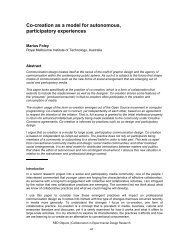Ceramic Tableware Recycling by Green Life 21 Project - Red Objects
Ceramic Tableware Recycling by Green Life 21 Project - Red Objects
Ceramic Tableware Recycling by Green Life 21 Project - Red Objects
Create successful ePaper yourself
Turn your PDF publications into a flip-book with our unique Google optimized e-Paper software.
mass-production in Japan. It produces approximately 60% of the entire production volume in Japan<br />
and the area has a history of expanding production businesses in a mass-consumption economy.<br />
Given this background, the Mino ware production area is highly aware that global environmental<br />
issues, including waste measures, are a significant challenge when maintaining and developing the<br />
production area.<br />
The global environmental issue in terms of ceramic ware is to reduce the environmental burden<br />
from the overall product life-cycle: from raw material procurement, manufacturing, logistics, usage<br />
to disposal. We now face three problems. The first is the sustainable use of exhaustible resources,<br />
such as clay, silica stones, and feldspar. There are concerns over shortages in raw materials due to<br />
mine closures and the exhaustion of quality materials. Reusing used tableware is one<br />
countermeasure. Second, there is the issue of reducing energy consumption and CO2 emission<br />
during firing in the ceramic manufacturing process. The firing process includes many steps, such as<br />
bisque firing, glaze firing and overglaze firing and its energy consumption, as converted into<br />
amounts of CO2 emission, accounts for approximately 70% of the overall manufacturing process.<br />
As the oil price becomes higher, more reduction of firing energy is needed. Third, there is the use of<br />
metal oxides for coloring and painting tableware(Miyachi & Hasegawa 2009, p. 31). It is obvious<br />
that we are required not only to comply with the Food Sanitation Act concerning the elution of lead<br />
and cadmium, but also to procure raw materials in a way that has less impact on the global<br />
environment.<br />
In order to respond to these global environmental issues, the Gifu Prefectural <strong>Ceramic</strong>s Research<br />
Institute, to which the author belongs, took the initiative to organize the <strong>Green</strong> <strong>Life</strong> <strong>21</strong> <strong>Project</strong><br />
(hereinafter referred to as “GL<strong>21</strong>”) with the voluntary participation of approximately 30 Mino ware<br />
companies. Together, we began to address these issues through ceramic ware recycling.<br />
2. <strong>Ceramic</strong> Ware <strong>Recycling</strong> Technology<br />
In order to recycle ceramic ware, it is necessary to start with establishing the recycling technology<br />
that makes it possible. Engineers from public research organizations are the main actors involved in<br />
this issue. The amount of used tableware that is discarded in Japan in one year is estimated to<br />
exceed approximately 100,000 tons and if industrial waste (fired products) in the production area is<br />
added, it amounts to about 140000 tons. Most of it is disposed in landfills. <strong>Ceramic</strong>s have the<br />
characteristics of being nonflammable, insoluble and indefectible, so material recycling is<br />
considered to be appropriate for the recycling of used tableware. Since the materials used for<br />
tableware are of good quality when compared with building materials or tiles, it is important to have<br />
a concept of circulation from tableware to tableware.<br />
The used tableware that is collected is reproduced after undergoing the processes needed to<br />
change it into raw materials as shown in Figure 1. Mino ware has set the standard for the ratio of<br />
combination of recycled materials at 20% because a higher combination ratio causes the lowthermal<br />
expansion of the green body and it ruins the compatibility of the green body and the glaze<br />
and decreases product strength. This standard also allows the use of existing manufacturing<br />
facilities and technologies, enables all manufacturers to enter into the recycling system and<br />
facilitates the expansion of recycling activities. The 20% of recycled materials combination may be<br />
an initial step in the ceramic ware recycling. Studies of the plasticity of recycled green body and the<br />
glaze that conforms to the green body (low-thermal expansion glaze) will be essential to reaching a<br />
high combination ratio. Further collaboration with engineers is required.<br />
RED <strong>Objects</strong>⏐⏐Collaboration in Experimental Design Research<br />
74




